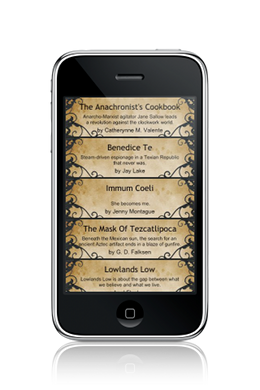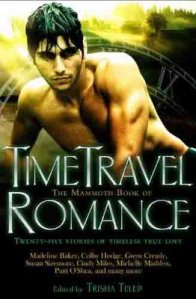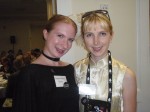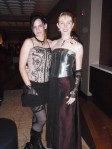When I volunteered to blog here, I had a look around the internet for information on Steampunk fashion, since that is a subject that fascinates me. In several places, I came across a notion about Victorian fashion that I knew was wrong, and I thought it would be fun to blog about it. Somehow, the idea has gotten fixed in some people’s minds that Victorian fashion was dark and rather gloomy, with an emphasis on black and dark brown. This is simply untrue.
First, I’d like to point out that the Victorian era was a long one, with significant shifts in fashion. I’ve noticed that many Americans think of Victorian times as being limited to the end of the nineteenth century. Actually, the era began in 1837, when Victoria ascended to the throne, and ended in 1901 with her death. Women’s fashion, especially, underwent major changes during those years.
In the beginning of the era, women’s style emphasized sloping shoulders, tiny waist and full, bell-shaped skirts. Women wore enormous bonnets that partially obscured their faces, and their movements were hampered by the many layers of petticoats they used to create the full skirt effect. In the 1850’s, the crinoline was invented, freeing women from the weight of all those skirts, and by the end of the century women’s clothes had taken on aspects of men’s style, such as shirtwaists and tailored suits with exaggerated broad shoulders (although retaining the artificially tiny waist). Color was used generously throughout the era.
A Victorian lady wearing all-black would generally be assumed to be in mourning. Victorian women loved color in their clothing. Aniline dyes were invented in mid-century, making it possible to create brighter colors than had been available previously, and women took full advantage of this. Even gentlemen wore colorful garments, although their choices were much more subdued generally than the women’s.
I Googled Victorian men’s fashion and found a site called Victoriana, which had some men’s fashion plates for viewing. For the year 1868, from Harper’s Bazaar, I found these colors described: brown, dark claret, blue, drab (beige or light taupe), and gloves of golden brown or maroon. For lounge jackets, the fashion was to make them of gray cloth lined with purple, crimson or green flannel, trimmed with soutache (a kind of braid) in the color of the lining. The magazine also referred to an English style of “full dress”, for evening entertainments, consisting of blue coat, white vest and lavender pantaloons and gloves. In the 1840’s plates, I noticed these colors: black, dark brown, medium brown or tan, navy blue, burgundy, dove grey, a very colorful red spotted or checked fabric on a waistcoat, and several pairs of pantaloons with either striped or checked fabric.
My copy of Mr. Godey’s Ladies (a compendium of the popular magazine) shows much color variation over the decades from the 1830’s to the 1860’s. From the fashion plates, I find rose, blonde (cream or ecru), blush, pale lavender, maize, blue, purple, maroon, black, gray, pearl, plum, and “tan d’or” (a golden tan, judging by the plate). This list comes from just two fashion plates from the years 1858 and 1860.
I also have a copy of La Mode Illustre, a French fashion magazine, for the years 1860 – 1914. Technically not Victorian, in my opinion, since it’s French and we all know the French and English don’t appreciate being confused with one another, but a beautiful book for anyone interested in the bustle years. Unfortunately, the pictures are all in black and white, but they do give color descriptions.
Here are the colors given for one plate from 1860: bright blue, orange-and-black striped, black, green edged with black velvet, violet, pale green, white blonde. This plate describes day dresses, so the bright colors are not only for evening. Here is another from 1881: “dress of white batiste and blue satin damask” . . . “white broderie anglaise percale dress, over plum surah underdress.”
And speaking of color, I found this amusing tidbit in a book titled Victorian and Edwardian Fashions for Women 1840-1919, by Kristina Harris. She’s referring to the 1850’s here: “For some time having being (sic) virginally white, petticoats suddently became popular in scarlet red when Queen Victoria was reported to have switched to the color ‘to reawaken the dormant conjugal susceptibility of Prince Albert.’ ” I had to laugh at that. I wonder if a red skirt would awaken my husband’s “conjugal susceptibility?” Not that his is dormant, of course.
Naturally, people working in laboratories and workshops would have worn more practical, and probably dull-colored, garments. So, if you have a mad scientist, he might not want to be dressed in lavender pantaloons . . . unless he’s attending a party or ball. Your girl genius might have a work apron over her dress, but if she’s going out in the evening, I say let her go in full color! It’s perfectly period.
Read Full Post »
 A touch at the center of the screen brings you to the main menu. In “Settings”, you can choose your reading orientation, add a fun turning page sound, decide on the font style and size and also chose another paper-like background. In “Index”, you can decide on the story of your choice and “About” gives you the background of the authors.
A touch at the center of the screen brings you to the main menu. In “Settings”, you can choose your reading orientation, add a fun turning page sound, decide on the font style and size and also chose another paper-like background. In “Index”, you can decide on the story of your choice and “About” gives you the background of the authors.












 Film Adaptations
Film Adaptations